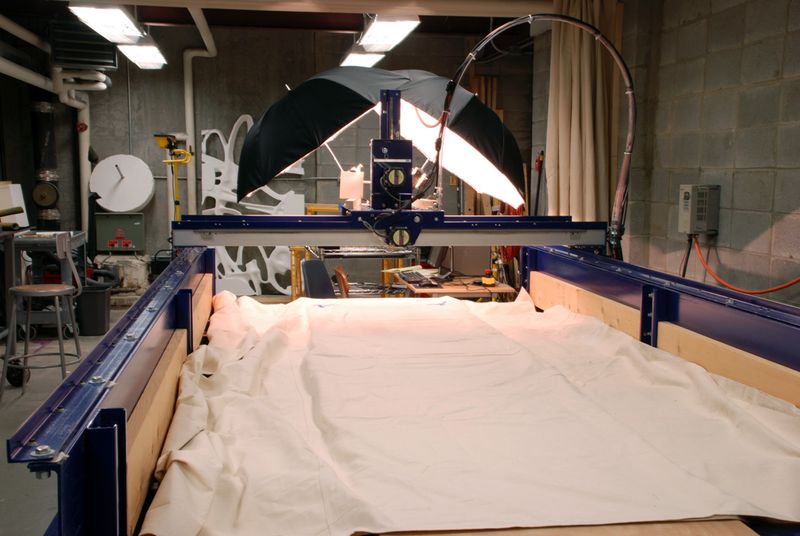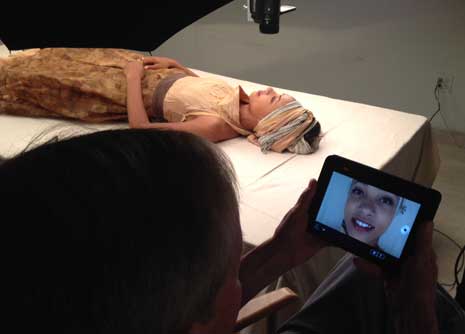Artist Bo Gehring: Reminding Us to Slow Down
Esperanza Spalding is a very busy person. A Grammy Award-winning musician, she captivates audiences on the international stage, from New York to Rio and Tokyo to Paris. She’s played everything from button-down jazz festivals to black tie evenings at the White House. Such is the life of a rising jazz icon.
In her portrait session with Bo Gehring, winner of our Outwin Boochever Portrait Competition 2013, Spalding found a welcome moment of contemplation. A camera slowly passed over her body, while a favorite song by Wayne Shorter held the air. When it was over, she thanked Gehring for “reminding me to slow down and enjoy life.”
Bo Gehring came to portraiture from a career spanning engineering, Hollywood animation, 3D-sound design, and metal sculpture. After a project making casting patterns for a building in lower Manhattan, he found himself with an industrial-sized milling machine on his hands—a precision-guided tool used to machine materials into exacting sizes and shapes.
With its computer-guided positioning and speed control, he realized the machine could move a camera with unparalleled precision. “The idea just came to me in a second. The machine is so big—the size of a double bed basically—one could easily recline in it.” He could move a camera over a person’s entire body from toe to head with mathematic smoothness. And by positioning the camera extremely close—closer than the human eye can focus—breathing, pulse, and stitches of clothing are brought into intimate view.
Bo Gehring is an avid music listener, so naturally it is central to his portraiture. He feels strongly in the emotional power of music: that a song can tap into and help reveal a person’s deeper self. Before entering his camera contraption, a subject is instructed to pick a song—a track he or she loves and feels especially connected to.
Spalding chose Wayne Shorter’s “Tarde” from his 1974 album Native Dancer, featuring Shorter on tenor saxophone, Milton Nascimento on vocals, and Herbie Hancock on electric piano. She selected the song because “Herbie, Wayne, and Milton are part of me.”
Gehring first came to the National Portrait Gallery’s attention with his video portrait Jessica Wickham, which won first prize in the museum’s 2013 Outwin Boochever Portrait Competition.
In the portrait, Wickham, a precision woodworker, is dressed in her work clothes. Her chosen music, “Cantus in Memory of Benjamin Britten” by Arvo Pärt, builds slowly in grand, sorrowful chords. As the camera moves slowly from her orange crocs, to her corduroy pants, and then to her face, she is seen immersed in the music, gazing towards the camera, and then emptily away. “I’ve seen it a hundred times and still tear up when it plays,” says Gehring.

Winning the Outwin Boochever Portrait Competition not only netted Gehring a $25,000 cash prize and his work displayed in the National Portrait Gallery, but it also came with the opportunity to do a commission for the museum. This was the path that led him to Esperanza Spalding.
Gehring says he was not very familiar with Spalding’s music, but the two seemed to connect quickly, as artists sometimes do. Of the portrait process, he said “She got this in one second. She took a look at it, and I didn’t have to explain anything. She just started getting into the camera.” With Gehring’s love of music and the central role it plays in his portraits, Gehring’s portrait process was a natural fit between artist and subject.
Esperanza Spalding, who also has a style blog, wore an outfit well suited for the close-up nature of Gehring’s portraits. Her skirt, made by Tara St. James of Study, a New York–based ethical brand, was meticulously constructed from sustainable materials—it is almost quilt-like, made of tiny earth-toned patches of fabric. As the camera slowly moves along, the fabric becomes infinite and immersive. Says Gehring, “It’s like watching a thousand paintings go by as the music plays.”
Esperanza Spalding’s portrait can be seen on the National Portrait Gallery’s YouTube page and will be on display in May 2015 in the museum’s galleries.
Can you envision your work on the walls of the National Portrait Gallery? Visit the Outwin Boochever Portrait Competition website and submit your work for the 2016 competition. The call for entries ends November 30, 2014.
— Benjamin Bloom, Smithsonian National Portrait Gallery

